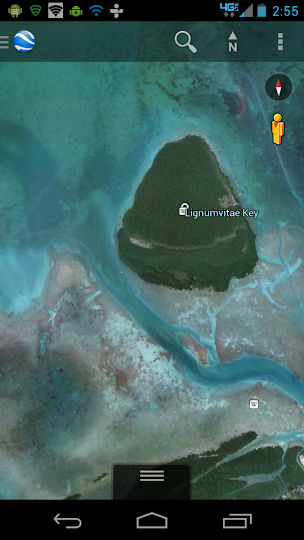On the way down here, we stopped at John Pennekamp State Park in Key Largo. Although we have heard of this park for a long time, we have never been there before. It turned out to be a very pleasant surprise.
The park has five diverse attractions.
- It includes part of the barrier reef protecting The Hawk Channel. Out there on the reef are moorings for day use where one can stop and snorkel. We never stopped at one of those moorings because we always went past on breezy days when it is too rough for snorkeling. On calm days, we can find the same thing closer at Sombrero Reef, just 4 miles from Boot Key Harbor.
- There is a coral aquarium at the visitors center. That is what I'll talk about below.
- There are nice nature trails. Some taking you through the mangrove swamp. Some taking you through the hammock forest. We walked those and they were very nice. Some Japanese tourists there at the same time were astounded at the big iguanas sitting in the tree branches above their heads. We even ran into a family from Sweden out in the mangroves, and we shocked them when they found that we could understand what they were saying.
- There is a basin with moorings and a marina with slips, and a nice beach. It looks very nice, but according to our friends, it is too shallow for cruising boats to get in to. Too bad.
- They have glass bottom boat tours. They weren't operating when we were there, but I suspect that the tour might be lots of fun.
Our previous encounters with coral were in the Virgin Islands. I snorkeled at St. Croix in the early 1970s. We also snorkeled in the British Virgin Islands in the mid 1970s. We returned to the BVIs in the 90s but we were saddened to learn that almost all the coral we saw before was dead. Today, it is incresingly difficult to find heathy coral at snorkeling depths. Belize in The Atlantic and the Great Barrier Reef in Austrailia come to mind, but those are very hard to get to.
Therefore, I was delighted to find wonderfully healthy coral in the Pennekamp aquarium. Someone did a great job there. The surprise benefit was that in the aquarium setting, one can spend a lot more time peering at the coral and admiring their beauty than is possible when you are diving. It can't quite match the marvel of diving on a thriving reef, but it was close. Those corals are fascinating creatures. Hats off to John Pennekamp.
If you travel to the keys, a stop at John Pennekamp park is well worth your while.
I'll blog my own pictures soon, but for now here are a few pictures of the park I found on the Internet.
















